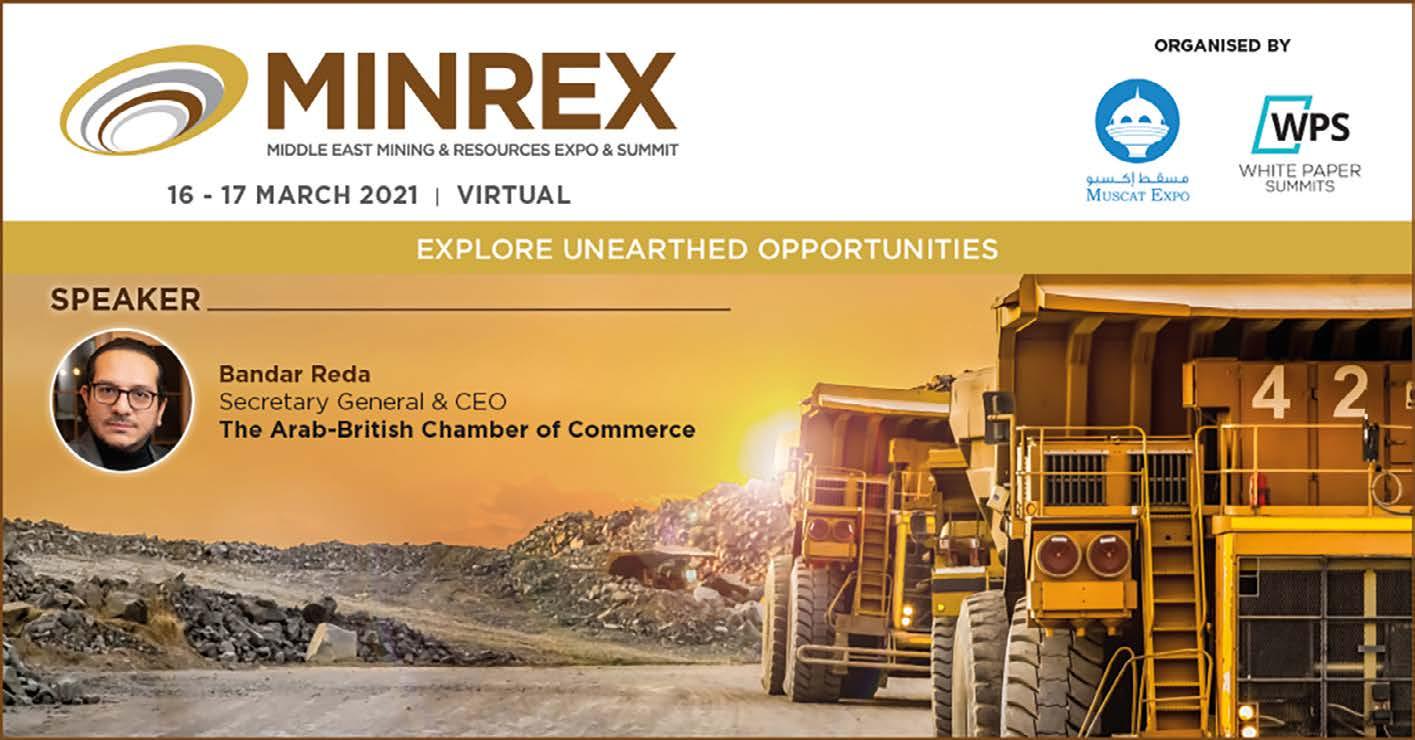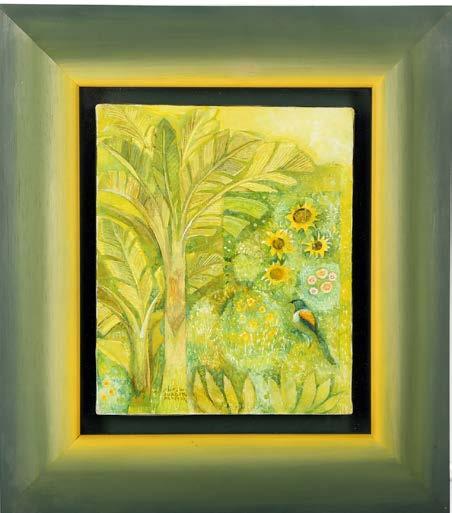
8 minute read
Arab Mineral Resources
Arab Countries Rich in Mineral Resources
Mr Bandar Reda, ABCC Secretary General & CEO, participated in the MINREX Virtual Expo & Summit, an international conference on the Arab mining industry held on 16-17 March 2021.
MINREX is a global strategic event that focuses on the future of mining, minerals, quarrying industries and addressed sustainable solutions for exploration, refining, technology, investment and industrial development.
What follows are some of the key points made in Mr Reda’s presentation to the event held virtually.
Our CEO began with a brief overview of the mineral resources in the Arab world, which is an immensely resource rich region and one whose potential remains largely untapped.
Mr Reda then outlined the innovations that are driving forward the industry guided by the Arab vision for mining within the broader social and economic vision for future sustainability.
Finally, the presentation highlights areas for investment and cooperation.
The Arab countries are actively welcoming foreign investment and collaboration.
Recent studies of the Arab region estimate the value of mineral reserves as exceeding US$1 trillion.
New mining codes and updated regulations have started to open up business opportunities within mining, making it far more attractive to foreign investment. There is a government support structure in place to assist investors. There are several factors new today that make the sector more attractive, and one to watch. A key factor is the growth in new technology which is transforming how mining is carried out.
The development of new computer devices and smart phones that require various rare metals for their production and functioning is increasing the demand for raw materials and stimulating mining exploration and extraction.
Mining is identified as a priority industry as the Arab economies reduce their dependence on oil.
Prospects are looking exceptionally good as the economy recovers from the global pandemic.
Activity in the construction industry is making a major contribution to the growth in mining activity.
Huge megaprojects and extensive infrastructure plans around the Arab world all require products and equipment made from the metals and minerals that are ultimately derived from mining processes.
RICH IN RESOURCES
Although the countries of the Arab world are rich in resources much is still largely under explored:
• One of the smallest Arab states,
Djibouti, is believed to contain high concentrations of gold. Other resources include clay, granite and marble.
• Mauritania is particularly rich in iron ore, of which it is Africa’s second largest exporter. Its other mineral deposits include tin, gold, copper, lead, chrome, phosphate, tungsten and chrome. There have also been discoveries of uranium and diamonds.
• Oman is rich in copper, gold, zinc, chromite, cobalt and iron ore and stones such as dolomite, limestone, gypsum and silica.
• Sudan has iron, copper, and gold.
• Algeria possesses iron ore said to be the largest reserves in the Arab
World. It also has gold, phosphates, lead and zinc. Others include diamonds, gems and uranium.
• Egypt has gold, iron ore, large quantities of phosphates and one of the largest tantalite reserves in the world. Egypt also has raw manganese used in steel production, solid batteries, paints and chemicals.

• Morocco’s known mineral resources include phosphate rock, barite, copper and silver. It also has significant reserves of tin, gold, zinc, iron, cobalt, coal and manganese.
• Tunisia’s mineral resources are iron, phosphates, lead and zinc.
• Saudi Arabia with its huge landmass possesses vast mineral wealth.
There are up to 50 different mineral deposits, many commercially viable, and of high value, such as aluminium, phosphates, gold, silver, copper, zinc, uranium, lead, iron, tin, chrome, nickel, platinum, tantalum, titanium.
Under the Saudi Vision 2030 mining is one of four key sectors in the National Industrial Development programme whose aim is to achieve, “A mining sector contributing to the national economy at full potential”.
This process opens up tremendous opportunities for global investors with relevant expertise and knowledge to the optimal development of local mining capacity.
The shift from the export of raw materials towards more localised refining and production is essential to add value to local resources.
The world economy is going through a rapid digital transformation of historic proportions and mining is part of this process.
According to the World Bank and International Energy Agency, “the energy transition is significantly mineral intensive and there are expectations for a substantial increase in demand for several critical minerals and metals to manufacture renewable energy technologies: solar panels, wind turbines, advanced batteries and electric vehicles”.
The age of intelligent mining has a far reaching impact across the industry at all levels. Smart technology, Artificial Intelligence (AI) and big data are transforming how decisions are made, the skills that the industry needs and how mining engages with local communities and the environment.
Companies with innovation, expertise, know-how and forward thinking strategies are best placed to partner with the Arab countries in the implementation of their ambitious plans to maximise the advantages provided by the rich untapped natural resources.
In conclusion, Mr Reda stated that there was incredible potential for productive Arab-British collaboration in mining and the Arab British Chamber of Commerce remained ready to give support to investors in this growing sector.
The Growing Interest
in Middle East Art
Janet Rady is a specialist for Chiswick Auctions and is head of sale for their Modern & Contemporary Middle Eastern and North African department. She talks about the background to the Middle Eastern art market.

Interest in Modern and Contemporary Middle Eastern art has grown enormously in the last decade.
Whilst practitioners were making extraordinary works across the Arab and North African regions in their own original styles from the mid-20th century onwards and were finding outlets for their works either by selling directly from their studios or through local galleries in the capitals of say, Damascus, Baghdad, Amman, Beirut, Cairo and the Maghreb, there was no systematised formal vehicle for them to sell their work on a global scale.
This all changed in the mid-2000’s when there was a seismic shift in interest in the Middle East amongst art collectors.
The catalyst for this change came in the first instance from the ground-breaking exhibition at the British Museum in London entitled ‘Word into Art’ a survey of Arab and Iranian calligraphy and text based inspired works. This was followed shortly thereafter by the first auction of Middle Eastern art in Dubai, conducted by Christie’s in May 2016.
At the same time, John Martin a London gallerist, had been exploring the idea of holding an art fair in Dubai and the inaugural edition of the fair was held in Dubai in March 2017 (then called the Gulf Art Fair).
Interest followed from other auction houses and Bonhams set up an office there in 2007, with their first sale held shortly thereafter. The saleroom subsequently closed in Dubai and sales were held thereafter in their Bond Street rooms in London.
Galleries in the region (there had been a handful in Dubai before) began to expand and soon there was a thriving scene in Dubai, which attracted audiences and artists alike. Collectors started to form major collections of Arab art, the best known of which is undoubtedly that of Sultan Sooud AlQassemi of the ruling family in Sharjah.
Named the Barjeel collection, it is now houses in Sharjah and Sheikh Sultan has been actively engaged in promoting it internationally. Similarly in Sharjah, the long running low-key Biennale was taken over by Sheikha Hoor Al Qasimi in 2003 and has now become an internationally recognised platform for artists, comparable to that of the Venice Biennale.
The grand museum project for Saadiyat Island originally announced in early 2007 came to fruition with the opening of the Louvre Abu Dhabi in 2017 and plans for the Sheikh Zayed and Guggenheim Museums are ongoing there too.
Back to the auction world. After Christie’s success in Dubai, Sotheby’s started to hold dedicated sales of Middle Eastern art in London and later established offices in Doha and Dubai, again holding annual auctions there.
Other auction houses sprung up in places such as Qatar – al Bahie auctions and Beirut – Artscoops, as well as CIMOAA in Morocco. There is now a healthy secondary market for artists, both past and present, all of which contributes to a burgeoning market.
In London, Chiswick Auctions held its inaugural sale of Modern and Contemporary Middle Eastern & North African art in October 2020. This was followed by our second sale on 22 April 2020, which building upon the first sale, was a great success. Many Arab works sold above their predicted high estimates, including two important Arab female artists - a painting by the Egyptian artist Tahia Halim, which sold for £20,800 (inc premium) and a work by Baya, the Algerian artist, which sold for £22,100 (inc premium).
Our next auction is scheduled to take place in October and we are now welcoming consignments.
If you would like information on future auctions please contact Janet Rady on janet.rady@chiswickauctions.co.uk

Based between London and the United Arab Emirates, Janet Rady is a Specialist in Modern and Contemporary Art from the Middle East, with over thirty years’ experience of the International Art Market in both leading auction houses and major commercial galleries. Born in Malta, Janet first visited the Middle East in 1974, when she went to Iran and subsequently lived there from 1983-84. She now travels regularly to the region.










